.
19.07.2014
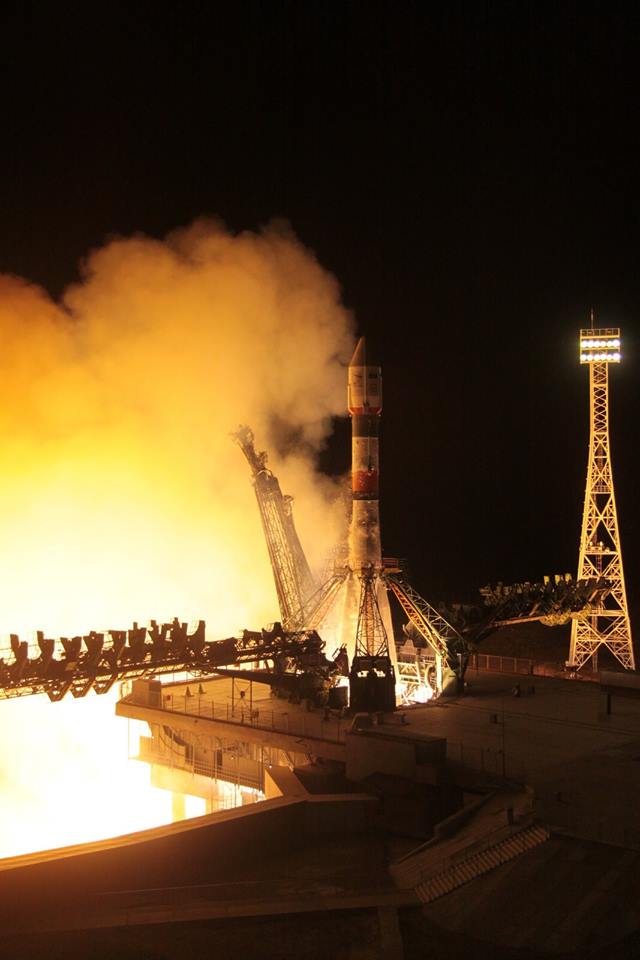
Russia launched its fourth Foton-M research satellite on Friday (UTC) to begin a sixty-day mission for an array of creatures and biological experiments. Liftoff atop a Soyuz-2-1a rocket from the Baikonur Cosmodrome occurred at 02:50 local time (20:50 UTC on Friday), although the broadcast appeared to unavailable – once again – for some people in Western countries.
Russian Launch:
The Foton-M No.4 is a 6,840 kilogram (15,100 lb) microgravity research satellite which is designed to be recovered following its mission.
To return its experiments to Earth, the spacecraft makes use of a return capsule derived from the one developed to bring early cosmonauts back to Earth at the end of the Vostok and Voskhod missions in the early 1960s.
The Vostok spacecraft first flew in May 1960 on the unmanned Korabl-Sputnik 1 test flight. Followed by six more unmanned tests over the following year, the Vostok was ready for service in April 1961. On 12 April Yuri Gagarin became the first man to fly in space aboard Vostok 1, the first of six manned flights between 1961 and 1963.
Although the spacecraft was recovered intact, the Vostok was not designed so that the crew could land aboard it – instead the single cosmonaut ejected from the spacecraft following reentry and descended under their own parachute.
The Vostok has spawned several derivatives. Those which have flown the most are the variants designed for earth observation and reconnaissance.
The Zenit was the Soviet Union’s first reconnaissance satellite, launched in several versions between December 1961 and June 1994. The spacecraft carried cameras in its reentry module which were recovered along with their film at the end of a successful mission.
A leftover Zenit-8 satellite was the payload for the Soyuz-2-1a’s maiden flight in 2004. A suborbital mission, the satellite was never intended for operation and reentered shortly after its successful launch.
Some satellites used for the Resurs remote sensing program were built using the same configuration as the Zenit; the Resurs-F1 and F2. The Yantar-1KFT, or Kometa, made use of the Zenit’s film capsule coupled with the equipment module used on other Yantar satellites.
Designed to help the Soviet Union keep ahead of the American Gemini program, the Voskhod were a series of modified Vostoks built to accomplish more advanced missions than the Vostok had been designed for.
The Voskhod 1 spacecraft was fitted with three seats – fitted at the expense of the ejection system which doubled as a launch escape system on earlier missions. Due to the limited space available, the crew were also unable to wear spacesuits.
Voskhod 2 was customised to allow the Soviet Union to achieve the first spacewalk. With two seats, room was left for the crew to wear spacesuits however the ejection system still had to be omitted.
An inflatable airlock was attached to the side of the vehicle, which was used by Alexei Leonov to exit the spacecraft and spend 13 minutes outside.
Four further Voskhod missions were planned; however the program was cancelled in favour of the more capable Soyuz spacecraft then in development.
One of the remaining satellites was launched as Kosmos 110, a bioscience research mission which spawned the Bion series of recoverable research satellites. Also derived from the Vostok, the eleven Bion missions conducted biological research in orbit, allowing the return of specimens to Earth for study or dissection.
Bion was replaced by the Bion-M, which retained the Vostok capsule but introduced an equipment module derived from Yantar reconnaissance satellites to extend its on-orbit lifespan. The first Bion-M mission was launched in 2013.
The Foton program began in April 1985 with Kosmos 1645. The first of twelve first-generation spacecraft whose launches continued until 1999, this spacecraft used the same configuration as Bion but for microgravity, rather than biological, research. Launches were made from the Plesetsk Cosmodrome using Soyuz-U rockets.
The Foton-M was a modernised version of the Foton introduced in 2002 to take advantage of advances in communications and power system technology. The Foton-M No.1 mission was launched in October 2002, however it failed to achieve orbit.
The Soyuz-U rocket which was carrying it suffered a first stage engine failure and fell close to the launch pad, killing a soldier and injuring several more, all of whom were standing close to windows in a nearby building.
Two more missions were conducted, successfully, in 2005 and 2007.
The Foton-M No.4 spacecraft differs from the three earlier Foton-M missions by its use of the Yantar equipment module rather than that of the Vostok and Zenit.
A configuration already proven by the Kometa and the Bion-M, the Yantar module allows the spacecraft to remain in orbit for longer than it would have been able to with a standard equipment module.
On board are a host of creatures and biological experiments, ranging from Geckos to plant seeds.
Russia’s Soyuz-2-1a rocket was used to launch Foton-M No.4. First flown in November 2004 it will be making the thirty-sixth flight of a Soyuz-2 rocket.
The type, which is derived from the earlier Soyuz-U and the Soyuz 11A511 before that, was intended as an eventual replacement for all of the Soyuz and Molniya variants then in service.
The Molniya-M was retired from service in 2010 and the Soyuz-2 has already replaced the Soyuz-U for all launches apart from Progress missions to the International Space Station. The first Progress launch on a Soyuz-2-1a is scheduled for later this year.
The Soyuz-2 has three principal variants; the 2-1a, 2-1b and 2-1v (v being the Romanisation of the third letter of the Cyrillic alphabet). The 2-1a is a modernised version of the Soyuz-U, while the 2-1b introduces a new RD-0124 second stage engine. The Soyuz-2-1v, which is also known as Soyuz-1, uses an NK-33 engine to power the core stage and does away with the four boosters flown on all other Soyuz rockets.
The first and second stages of the Soyuz-2-1a burn in parallel; the first stage consists of four strap-on boosters powered by RD-117 engines, clustered around the core, or second stage, which is powered by an RD-118. Atop the core sits a third stage with an RD-0120 engine which will fire to inject the Foton spacecraft into its final orbit.
The launch was conducted from Site 31/6 at the Baikonur Cosmodrome. One of two Soyuz pads at the site, and seven in the world, 31/6 was originally built for tests of the R-7 missile upon which the Soyuz is based.
Following the end of R-7 testing at Baikonur the complex was converted to support orbital launches. Until pad 1/5 is renovated, 31/6 is the only one of the Baikonur complexes from which the Soyuz-2 can fly.
The launch was the forty second of the year and the nineteenth for Russia, including the Proton launch failure in May and two Soyuz launches from French Guiana. It is the twelfth Soyuz rocket to fly this year and the seventh Soyuz-2.
The next Soyuz launch is slated for the coming week, when a Soyuz-U will orbit the Progress M-24M resupply craft. The Soyuz-2 will next be in action in August, lofting a pair of Galileo navigation satellites for Europe.
Quelle: NS
.
Live animals launched on two-month space mission
.
A high-flying package of live animals, plant seeds, and materials samples shot into space Friday aboard a retrievable Russian Foton satellite, launching a two-month mission focusing on microgravity research into biological and physical sciences.
The workhorse launcher fired its kerosene-fueled engines and lifted off from the Baikonur Cosmodrome in Kazakhstan at 2050 GMT (4:50 p.m. EDT), rocketing into a clear sky over the historic spaceport.
Launch occurred at 2:50 a.m. local time at Baikonur.
The three-stage Soyuz 2-1a rocket, a modernized version of the venerable launch vehicle, put the Foton M4 space capsule in orbit less than 10 minutes later.
The Russian Federal Space Agency, or Roscosmos, declared the launch a success on its website.
The more than 15,000-pound Foton M4 space capsule launched by the Soyuz rocket is due to spend up to 60 days in orbit, hosting 22 experiments supplied by Russian and German institutions probing questions in biological and materials sciences.
When the mission is complete, the spacecraft will break apart and its spherical landing capsule -- fitted with a heat shield -- will return to Earth with a parachute-assisted landing in Russia.
The re-entry capsule's design is based on the Vostok spacecraft that carried Yuri Gagarin into orbit in 1961 on the first human spaceflight.
It carries experiments to study the effects of the harsh environment of space on organisms, manufacturing materials, plus other investigations.
.
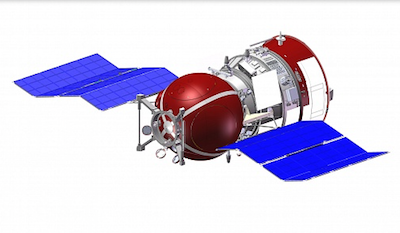
Artist's concept of the Foton M4 spacecraft. Credit: TsSKB Progress
According to information posted on the Roscosmos website, the Foton M4 spacecraft carries nearly 1,900 pounds of research hardware inside and outside the capsule.
A joint Russian-German experiment will study the growth of semiconductor crystals in microgravity, an investigation scientists hope will lead to advancements in solar cells, light emitting diodes, transistors and other applications in the electronics industry.
"The goal is to produce crystals with the highest possible quality," said a statement by DLR, the German space agency.
Three types of materials will be heated up inside a Russian-made furnace housed inside the Foton M4 spacecraft. Once melted, the samples will crystallize as scientists study the influence of magnetic fields and vibrations on their growth.
The materials samples will be divided among Russian and German scientists at the end of the mission.
Geckos and plant seeds are also flying inside the pressurized Foton M4 space capsule.
.
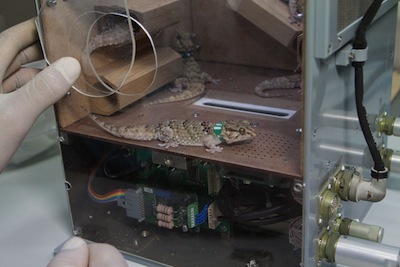
Scientists work with the gecko habitat on the Foton M4 mission. Credit: Roscosmos
Researchers will monitor the effects of microgravity on the adult geckos, including their sexual behavior and embryonic development, according to Roscosmos. Scientists will have a continuous video recording of the gecko habitat aboard the spacecraft.
Dried seeds and silkworm eggs inside the Foton space capsule will be studied to determine their response to cosmic radiation, and the satellite carries several experiments for research into microbes.
The mission marks the 16th flight of a recoverable Foton spacecraft since 1985.
The Foton M4 mission carries several upgrades to extend the duration of its flight, including solar panels to generate electricity and a new propulsion module to adjust its altitude.
Roscosmos says landing in southern Russia is scheduled for September.
Quelle: SN
.
Update: 28.08.2014
.
The decision on landing was made at a meeting of the state commission that reviewed the results of scientific experiments on the Photon-M satellite
Photon-M descent capsule to land on September 1 — Roscosmos
The landing of Russia’s Photon-M descent capsule is planned for September 1, the press service of the Federal Space Agency (Roscosmos) said on Wednesday.
The decision on landing was made at a meeting of the state commission that reviewed the results of scientific experiments on the Photon-M satellite, the agency told ITAR-TASS.
“The implementation of the scientific experiments’ program is over as of August 27. The state commission made the decision to land the Photon-M descent capsule in the Orenburg region on September 1,” Roscosmos said.
The Photon-M4 satellite was launched on July 19, 2014 from the Baikonur cosmodrome in Kazakhstan. Onboard the spacecraft are specimens for research on the biological effects of zero gravity and cosmic radiation. The specimens include geckos, silkworm eggs, dried seeds, fruit flies, and mushrooms. The geckos are part of biology experiments by Russia’s Institute of Medico-Biological Problems on the effects of weightlessness on mating.
Another experiment aboard the spacecraft is designed to measure the effects of microgravity on semiconductor crystal growth.
Several hours after the blastoff, the control communication with Photon-M was disrupted, although the spacecraft continued to transmit telemetric information. As a result of the malfunction, the satellite stayed on the support orbit, instead of being placed into the target orbit by its own engine on command from the Earth. The Institute of Medico-Biological Problems said after the control loss incident that it did not affect in any way the onboard life support system and the program of automatic experiments.
Quelle: ITARTASS
.
Update: 1.09.2014
.
Russia’s Photon-M scientific spacecraft set for landing on Monday
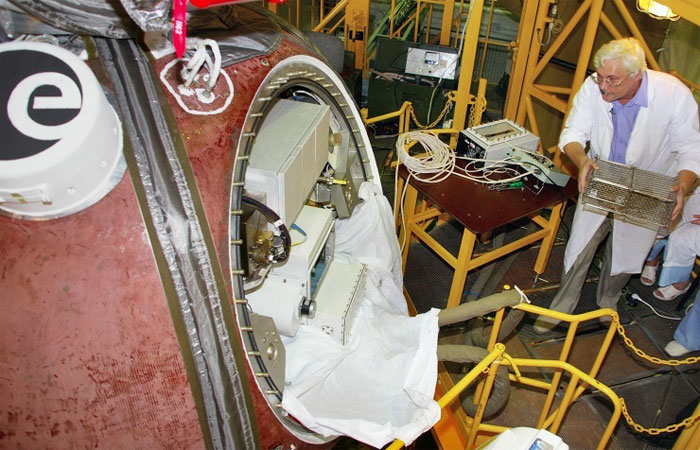
Russia’s Photon-M satellite is set to land on Monday in Russia’s southern Urals after spending over a month and a half in the space for scientific purposes, the Russian Space Agency (Roscosmos) reported.
“A state commission made a decision to land the descent capsule of Photon-M satellite in Russia’s Orenburg Region,” Roscosmos said. “The estimated time of landing is 13:18 Moscow time [9:18 GMT].”
The Photon-M4 satellite was launched on July 19, 2014 from the Baikonur space center in Kazakhstan. The spacecraft carried specimens for research on the biological effects of zero gravity and cosmic radiation.
The specimens include geckos, silkworm eggs, dried seeds, fruit flies, and mushrooms. The geckos are part of biology experiments by Russia’s Institute of Medico-Biological Problems on the effects of weightlessness on mating.
Another experiment aboard the spacecraft is designed to measure the effects of microgravity on semiconductor crystal growth.
Several hours after the blastoff, the control communication with Photon-M was disrupted, although the spacecraft continued to transmit telemetric information. As a result of the malfunction, the satellite stayed on the support orbit, instead of being placed into the designated orbit by its own engine on command from the Earth.
The Institute of Medico-Biological Problems said after the control loss incident that it did not affect in any way the onboard life support system and the program of automatic experiments.
It took seven days to restore the communication with the spacecraft.
Quelle: ITARTASS
-
Geckos, Fruit Flies Land Safely in Russia After Space Flight
.
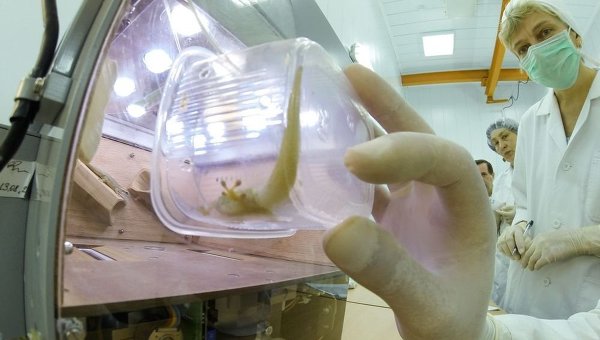
A biological capsule with geckos, fruit flies and silkworm eggs has returned to Earth, landing on Monday in the Orenburg Region, Russian Deputy Prime Minister Dmitry Rogozin announced on Twitter.
“Foton-M [the biological capsule] and its joyful crew are back on Earth,” Rogozin said in a tweet.
“In a short time the little space travelers will be removed from the capsule and then the scientists will be able to see how they dealt with the burden of the space flight,” a representative from Russia’s Roscosmos space agency said.
The biological mission of Foton-M included eight experiments that involved monitoring the reproductive activity of geckos in space. The space flight was also aimed at studying the influence of weightlessness on plants and insects and on growing semiconductor crystals.
The biosatellite experienced problems earlier in July, when communication with Foton-M was lost for more than a week but successfully restored. The design and onboard control systems of Foton-M enable its self-sufficient operation.
The satellite was launched on July 19 from the Baikonur Cosmodrome in Kazakhstan.
Quelle: RIANOVOSTI
.
Update: 2.09.2014
.
Russia confirms death of five geckos on space sex mission
Reptiles were part of zero-gravity research into reproduction
Geckos’ ‘mummified remains’ suggest they froze to death
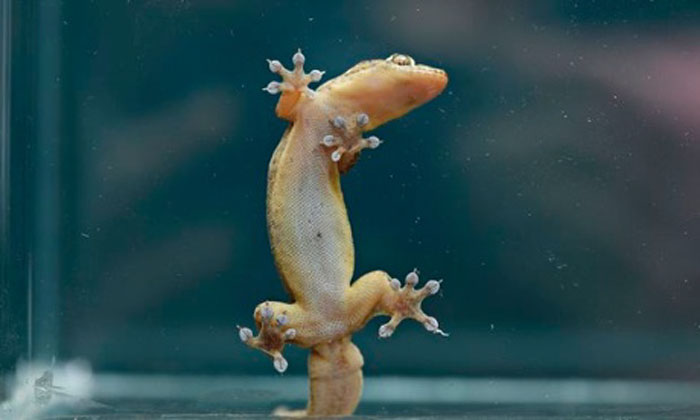
Russia sent four female geckos and one male into space. Photograph: Geckoskin
Russia’s space agency on Monday confirmed that five geckos, launched into space for an experiment on weightlessness and sexual behavior, have died.
The federal space agency released a statement saying the landing apparatus of the Photon-M satellite had returned to earth as planned, falling into Russia’s Orenburg region at 1.18pm Moscow time, and that the entire herpetological crew had perished at some point during their odyssey. With four female lizards and one male on board, Russian scientists had hoped to learn how zero gravity would affect the sexual habits of geckos.
A representative at the Institute of Biomedical Problems (ISTC), which participated in the experiment, explained to Russian news agency Itar-Tass simply said: “It’s still too early to talk about the geckos’ cause of death.” A source in a scientific commission involved later told the Interfax wire service that “According to the preliminary information, it became clear the geckos froze. Most likely, this happened due to a failure of the equipment meant to ensure the temperature of the box with the animals.”
He continued: “The geckos could have died at any stage of the flight, and it’s impossible to judge when based on the animals’ mummified remains.”
The space agency statement said simply that a “preliminary examination” found the geckos dead, and that “the date and conditions of their deaths will be determined by specialists”.
A source “who took part in securing the lander” told Interfax that “as usually happens in such instances, [the space agency] will soon appoint an emergency commission to find out these animals’ cause of death”.
An experiment with fruit flies was successful, the insects surviving and breeding, according to the space agency. The satellite also carried mushrooms and seeds, meant for tests related to gravity and radiation; all such biological material is being transported to labs for further inspection.
In July, Russia reported that it had lost contact with the satellite, and scientists were concernd that life-support systems could fail, leaving the geckos to die from hunger within three months, according to Interfax. A few days later, the space agency said it had re-established communications and that the experiment was back on track.
ISTC scientists told Itar Tass that loss of contact with the satellite should not have disturbed the animals’ support systems, and that geckos’ metabolisms, which are low relative to humans’, and sticky feet should counteract the effects of weightlessness.
Russia’s storied space program has had a troubled recent past, especially in the wake of poor relations with the US and Nasa. Two rockets have crashed and an Angora rocket launch was aborted since President Vladimir Putin’s May announcement that the government would invest $52bn in the space program.
Gerbils, newts, spiders, butterflies, snails and bacteria all successfully traversed the cosmos in 2007, when international scientists launched them from Russia for a set of 45 experiments.
Quelle: The Guardian
-
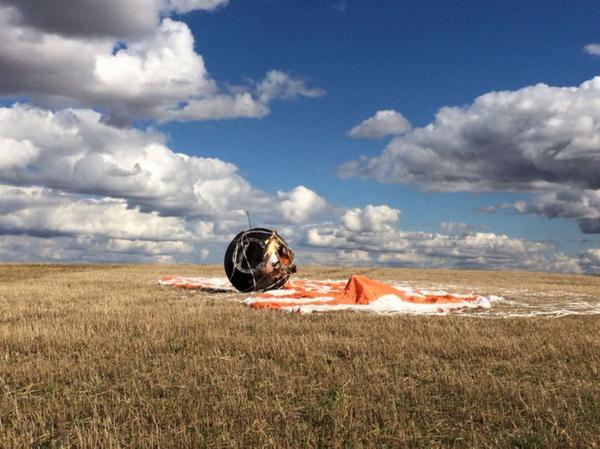
-

Descent module of FotonM4 satellite after touchdown with lost geckos
Quelle: Roscosmos
4831 Views
